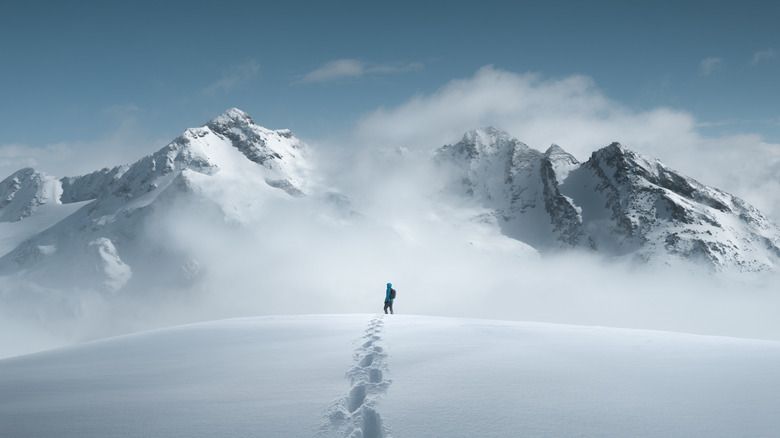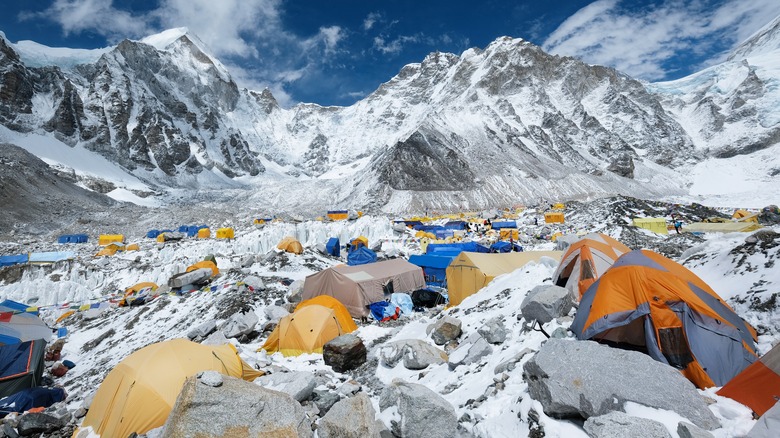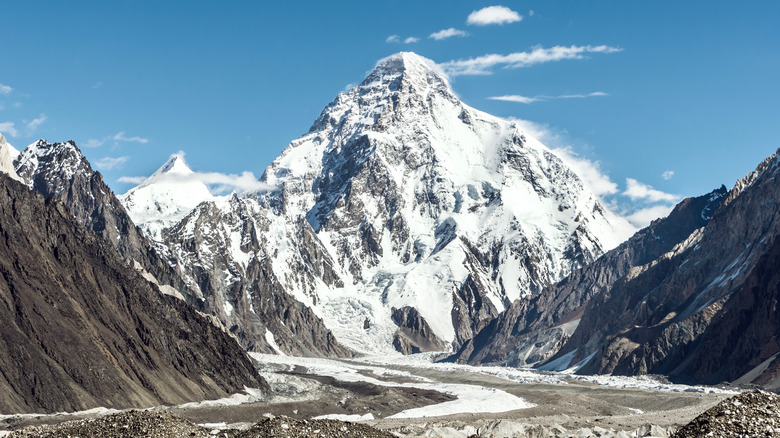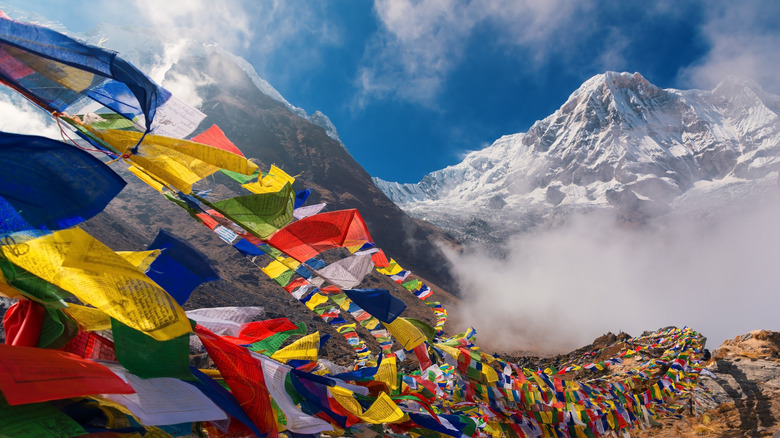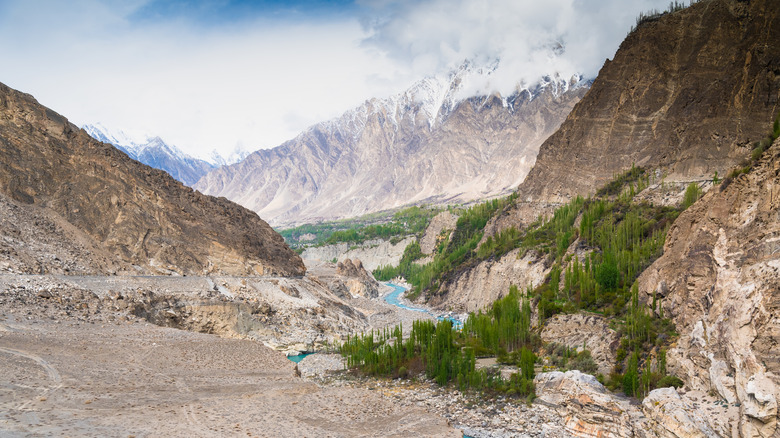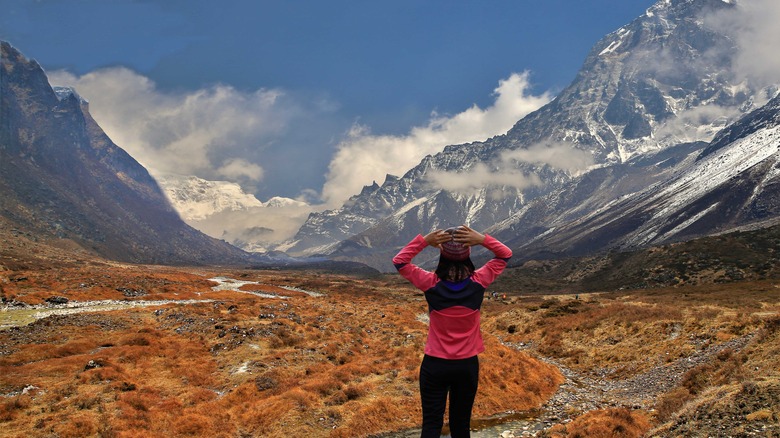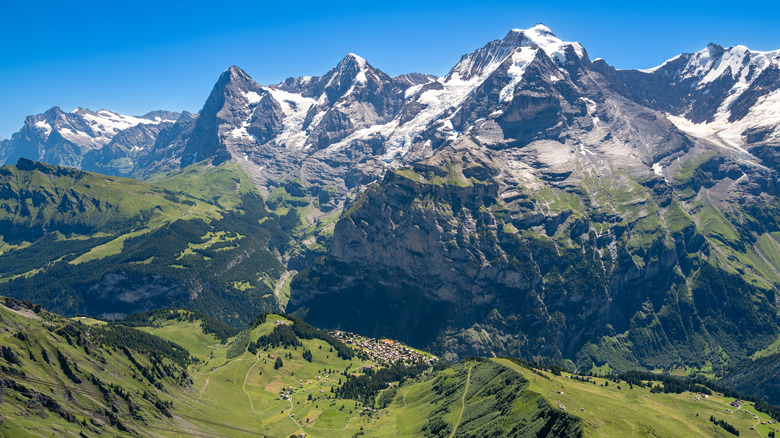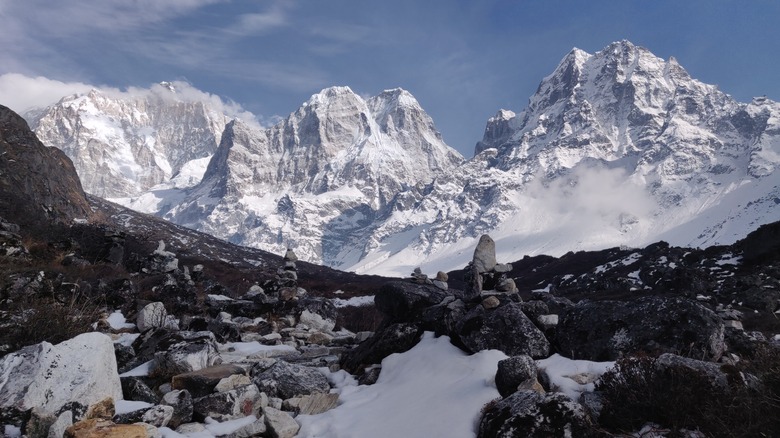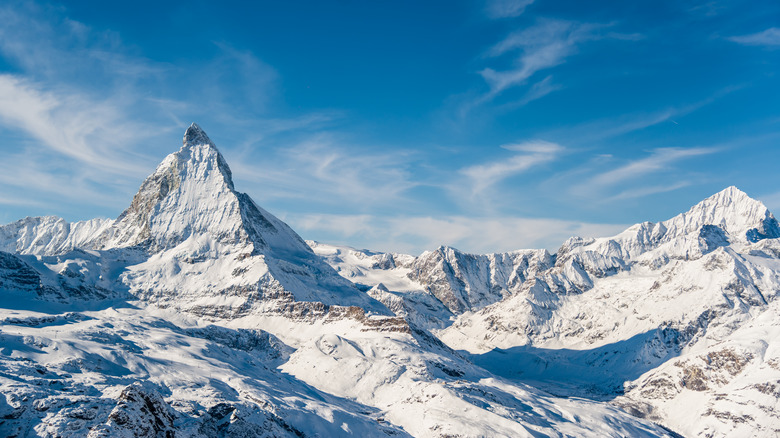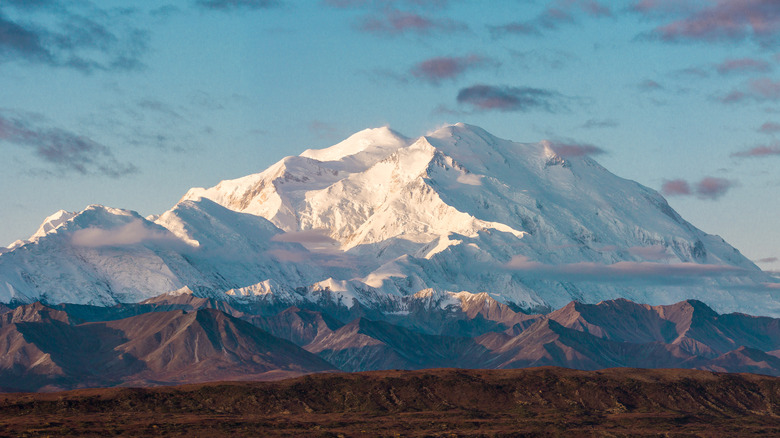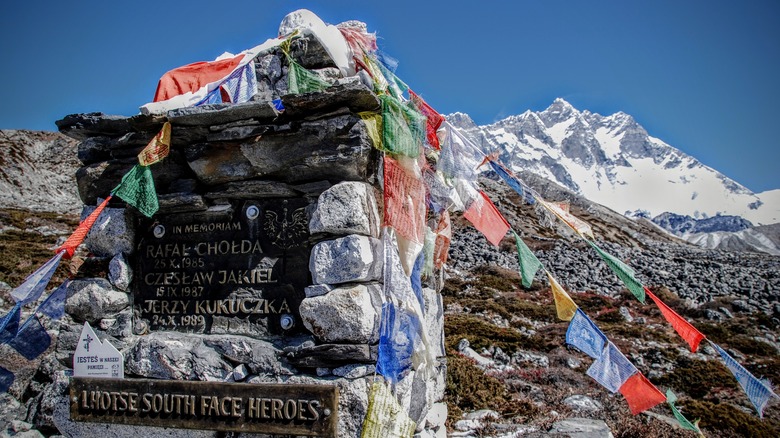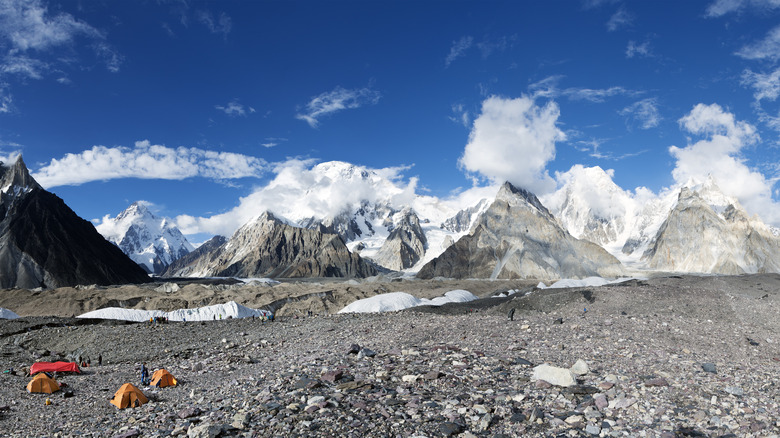The World's Most Treacherous Mountains To Climb
In the world of mountain climbing, there exist a select few individuals who are driven to conquer some of the most formidable peaks on the planet. These mountains, often referred to as the "deadliest" or "killer mountains," rise above the landscape, defying the very essence of nature's terrain. These formidable mountains, untouched by time, have stood as monumental challenges appealing to extreme mountain climbers since the advent of mountaineering. Their rugged and unyielding formations effortlessly defy gravity as their peaks loom majestically above the oceans from thousands of meters above. Venturing into their domain promises not only adventure but a terrifying confrontation with the limits of human physical and mental capabilities.
This is the exhilarating realm of extreme mountain climbing, where the allure of summiting the world's highest peaks becomes interwoven with the extraordinary challenges presented by the iciest, steepest, and most unpredictable terrains. Each of these treacherous mountains tells its own unique story, a captivating tale of allure and peril that beckons climbers from every corner of the globe. Together, these are the stories of the 11 most treacherous mountains to conquer.
Mount Everest: The Top of the World
Mount Everest, the tallest mountain on our planet, has long held a legendary status in the world of mountaineering. This towering colossus in the Himalayas has captured the imaginations of adventurers for decades, beckoning them with both awe and trepidation. Rising to an astonishing altitude of 29,029 feet (8,848 meters), it challenges climbers to not only grapple with the effects of extreme altitudes, but also contend with severe weather conditions that can be fatal in an instant.
According to Wired, one of the most perilous sections of the Everest climb is the Khumbu Icefall, an ever-shifting expanse of heavily crevassed terrain fraught with high risks of avalanches and icefall collapses. Climbers must tread this treacherous ground with meticulous care, avoiding not only the labyrinthine crevasses but also the menacing hazard of falling ice blocks. Yet, navigating this icy labyrinth becomes an ordeal when blanketed in whiteout conditions, where visibility is reduced to nearly nothing, and intricate routes lead climbers into life-threatening predicaments. Disorientation, losing one's way, and a desperate struggle to survive are not uncommon.
In recent years, a new risk factor has emerged on Everest: overcrowding. With a growing number of climbers attempting the summit annually, the route can become congested. Unfortunately, contributing to these crowds are inexperienced climbers, who endanger not only themselves, but climbers around them by contributing to the formation of bottlenecks. These bottlenecks induce exhaustion, extended delays, and, in some instances, prolonged exposure to the unforgiving elements. As the allure of conquering Everest draws more aspirants, the challenge multiplies exponentially.
K2: The Savage Mountain
Nestled in the heart of the Karakoram Range, K2, often referred to as the "Savage Mountain," which soars to 28,251 feet (8,611 meters) and boasts a reputation as one of the deadliest peaks. Its reputation is well-deserved due to its steep incline, technical rock and ice climbing requirements, and constant risk of falling or avalanches. Climbers must navigate treacherous sections like the Bottleneck, and carefully time their ascent within a narrow weather window.
Veteran mountaineer Jake Meyer, who has conquered both Everest and K2, highlights the unique challenges that make K2 more dangerous on Business Insider. Unlike Everest, where multiple routes offer varying levels of difficulty, K2's routes all involve sustained steep climbs averaging 45 degrees. The mountain is prone to falling rocks and avalanches, making safety equipment, including helmets, a constant necessity. Camping on K2 is another hazardous aspect. Campsites are significantly smaller and less accommodating compared to the popular Everest. Sherpas, crucial for guiding climbers, are more abundant on Everest, while K2 lacks this advantage. The Khumbu Icefall on Everest is dangerous, but K2's Bottleneck, despite technical similarities, is much more perilous due to its higher altitude.
K2's daunting nature is evident in the infrequent summit successes, with years passing without successful summits, and numerous fatalities due to its treacherous conditions. Everest, in contrast, sees hundreds of summits annually. The stark contrast between these two formidable peaks emphasizes K2's status as a true test of human endurance and courage.
Annapurna I: The Goddess of the Harvest
Annapurna I, translated to the "Goddess of the Harvest," is a towering peak in the Himalayas that has both lured and haunted mountaineers for decades. Annapurna I has a reputation for an exceptionally high fatality rate with 72 total lives claimed, earning it the grim title of "killer mountain." This mountain claims a notably high number of lives compared to other 8,000-meter peaks. The exact reasons for the high mortality rate are multifaceted, but steep terrain, unpredictable weather, and altitude-related illnesses contribute significantly.
Annapurna I is known for its extreme avalanche hazard. The loose snow and ice on its slopes are prone to avalanches, especially between December and February. The ever-present threat of avalanches looms large over climbers, demanding constant vigilance and careful route selection. Navigating Annapurna's intricate network of ridges and cliffs can be a daunting challenge. Mistakes in route-finding can lead climbers into precarious situations, where retreating is often as dangerous as progressing.
Annapurna's remote location in the Himalayas complicates rescue efforts in case of emergencies. Evacuations are challenging, often involving long and treacherous descents and difficult communication with rescue teams. The trials that Annapurna presents are not only physical but psychological, as climbers must continually make life-and-death decisions while navigating the unforgiving slopes of this imposing and lethal mountain.
Nanga Parbat: The Killer Mountain
Nanga Parbat, aptly named the "Killer Mountain," carries a notorious reputation in the world or mountaineering. Compared to other high-altitude mountains, Nanga Parbat's base camp is situated close to 4,000 meters high, which presents a significant risk of altitude-related illnesses, including pulmonary and cerebral edema. In addition, because she is situated in a remote region of the Himalayas, Nanga Parbat lacks the infrastructure and accessibility of more popular peaks. The nearest settlements are a considerable distance away, requiring climbers to embark on arduous journeys just to reach its base. The isolation can lead to climbers being stranded without quick assistance in the event of an emergency.
Nanga Parbat remote location and towering height contribute to the creation of fierce winds, heavy snowfall, and plummeting temperatures. Climbers are at constant risk of exposure, frostbite, and hypothermia. The combination of low temperatures and high altitudes can lead to altitude sickness, further endangering the climbers. Nanga Parbat is composed of a combination of rock and ice, which creates a rockfall hazard. Loose rocks and ice can dislodge from the mountain's cliffs, posing a constant danger to climbers. The unpredictable nature of these rockfalls adds another layer of risk to the ascent. The mountain's steep terrain, coupled with the heavy snowfall, creates a significant risk of avalanches. Nanga Parbat's complex topography, with numerous snow-loaded gullies and couloirs, increases the chances of avalanches that can bury climbers and block their routes. These avalanches are unpredictable and can be triggered by various factors, including changes in weather and the movement of climbers on the mountain.
Kangchenjunga: The Five Treasures of Snows
Kangchenjunga, often overshadowed by its more renowned neighbors in the Himalayan mountain range, is a formidable peak that commands respect among mountaineers. As the world's third-highest mountain, it stands, at 8,568 meres (28, 1689 feet) as one of the most treacherous and enigmatic climbs in the world, boasting a 20% fatality rate. Revered as the "Five Treasures of Snow" for its five distinct peaks, its cultural significance for Indigenous communities discourage troves of climbers from ascending the mountain.
Climbers on Kangchenjunga must negotiate a multitude of technical challenges. The ascent involves steep rock faces, icy slopes, and complex route-finding, making it a demanding climb that demands advanced technical proficiency. The presence of challenging technical sections adds to the overall danger and complexity of the climb. Navigating the intricate ridges and cliffs of Kangchenjunga's complex topography is a constant challenge. The mountain's intricate network of ridges and couloirs can disorient climbers, especially in poor weather conditions where visibility is limited. This complexity increases the risk of climbers losing their way or encountering difficulties on the route. Due to its technical difficulties and the challenges presented by the high altitude, Kangchenjunga expeditions often last several weeks, if not months. Prolonged exposure to the mountain's risks, combined with the logistical challenges of long expeditions, adds an element of risk in itself.
The Eiger: North Face's Deadly Challenge
The Eiger, a prominent peak in the Swiss Alps, is renowned for its notorious North Face — a formidable climb known for its unrelenting challenges and unforgiving nature. Standing at an elevation of 13,015 feet (3,967 meters), climbers find themselves at a high altitude, where the risk of altitude-related illnesses looms, emphasizing the critical importance of proper acclimatization and vigilant monitoring of vital signs. The high alpine environment requires climbers to be self-sufficient. The mountain's isolation and limited access mean that climbers must carry all necessary supplies with them, including food, shelter, and safety equipment. Climbing this formidable Swiss peak embodies the spirit of adventure, exploration, and a profound respect for the awe-inspiring power of nature.
The most striking characteristic of the Eiger's North Face is its sheer steepness. Vertical rock and ice faces, combined with challenging overhangs, demand advanced technical climbing skills. Climbers are frequently compelled to conquer sections that appear almost impossibly vertical, rendering this ascent one of the most technically demanding in the world . The high-altitude environment of the Eiger guarantees cold temperatures year-round. Sub-zero conditions prevail, particularly during overnight bivouacs, posing a constant threat of frostbite and hypothermia. The Eiger's North Face is prone to avalanches, especially in winter and early spring. The steep slopes accumulate loose snow and ice, creating an ever-present risk, necessitating cautious navigation by climbers. The complex and intricate nature of the Eiger's North Face can make route-finding a daunting task. Climbers must make precise decisions about their path, as any wrong choices can lead to perilous situations.
Makalu: The Great Black
Makalu, the fifth-highest mountain globally, is a captivating yet treacherous climb that offers unique and formidable challenges to mountaineers. At a staggering 27,766 feet (8,463 meters) above sea level, Makalu's summit is perched at an extreme altitude. Like many Himalayan peaks, Makalu is known for its unpredictable and rapidly changing weather patterns. Sudden storms, heavy snowfall, and plummeting temperatures are common at high altitudes. These adverse weather conditions not only hinder progress but also increase the risk of frostbite and hypothermia, especially during overnight stays.
Makalu's intricate topography adds an extra layer of challenge. Navigating the maze of ridges, cliffs, and crevasses demands precise route-finding. Errors in navigation can lead to perilous situations on the mountain, as misplaced footsteps can result in getting lost or stranded on treacherous terrain. Climbing Makalu involves navigating a complex terrain that includes steep rock faces and icy slopes. The mountain's steep and exposed sections require advanced technical climbing skills, such as ice and rock climbing techniques, making it exceptionally demanding for even the most experienced climbers.
The Matterhorn: The Mountain of Legends
The Matterhorn, a globally renowned and iconic mountain located in the Swiss Alps, is a captivating blend of natural beauty and treacherous challenges that continues to draw thousands of tourists annually. Beyond its picturesque façade, the Matterhorn holds a rich history and a unique set of characteristics that contribute to its distinct reputation.
This majestic peak, believed to be 50-60 million years old, is a testament to geological forces, formed when the African continental plate collided with the European one. While it's not the tallest in Switzerland, it stands as the 10th highest within the Swiss Alps and the 12th highest in Western Europe, towering at 4,478 meters. The Matterhorn's first ascent in 1865, led by Edward Whymper, marked a triumphant but tragic moment in mountaineering history, when the mountain claimed four of seven climbers' lives. Since then, over 500 people have lost their lives while climbing or descending the Matterhorn, earning it a reputation as one of the world's most dangerous mountains. What makes the Matterhorn particularly perilous is its sheer and treacherous rock faces. Climbers embarking on this journey must possess advanced rock climbing skills, as they navigate steep, exposed, and often near-vertical rock walls. Climbers must employ a range of equipment, including ropes, crampons, ice axes, and other specialized gear to safely negotiate the mountain's steep and rocky terrain.
Despite the risks, every year, thousands attempt the ascent, while the oldest person to conquer the Matterhorn did so at the age of 80. Modern climbers benefit from improved equipment and knowledge, reducing the time required to reach the summit. Yet, the mountain's treacherous nature remains a formidable challenge, with its popularity sometimes attracting climbers ill-prepared for the ascent. The Matterhorn's unique blend of beauty, danger, and historical significance continues to captivate the world, making it a symbol of both adventure and allure in the realm of mountaineering.
Denali (Mount McKinley): The High One
Denali, North America's highest peak, stands as one of the most challenging mountains on Earth, both for its imposing altitude and its extreme conditions. While its official name was Mt. McKinley from 1896 to 2015, it was renamed Denali, reflecting its indigenous significance, under President Obama. For the intrepid climbers who attempt Denali each year, the thin atmosphere, unpredictable weather, and bone-chilling temperatures present serious risks. In fact, the mountain's success rate hovers at around 50 percent, with over 100 climbers having lost their lives in pursuit of its summit. The mountain's cold and inhospitable environment has earned it a reputation as one of the coldest mountains globally, with frostbite and hypothermia a constant threat. Furthermore, the fierce and unrelenting winds on Denali can create whiteout conditions, making navigation difficult and endangering climbers with the risk of frostbite and disorientation.
Inclement weather, invisible crevasses, and treacherous terrain make Denali a complex and formidable challenge. Guided groups on Everest are statistically safer due to their accumulated climbing experience. On Denali, the challenge involves navigating hidden crevasses, detectable only by subtle variations in shading and slope. Climbers on Denali must not only rely on their technical skills but also develop a keen sense of intuition. This skill is critical for navigating the mountain's hidden crevasses, interpreting unpredictable weather patterns, and responding to unforeseen challenges. The ability to read the mountain and adapt to its unseen hazards is vital when confronting the unpredictable and extreme conditions of Denali.
Lhotse: The Neighbor of Everest
Lhotse, often overlooked in favor of its towering neighbor, Mount Everest, is a mountain that demands respect and poses unique challenges. While it's sometimes perceived as a "lesser" mountain, in reality, Lhotse has its own set of difficulties that make it a formidable peak to conquer. Lhotse's fatality rate, though lower than Everest's, still stands at 2.57%, proving its harshness (via Nepal Guide). The reasons for this grim statistic are multifaceted. Lhotse's steep and technical terrain, particularly its icy and precipitous slopes, presents a demanding climb that necessitates advanced technical climbing skills. Navigating these treacherous faces is further complicated by the constant threat of avalanches, adding an element of danger to the ascent.
Moreover, Lhotse shares the unpredictable and fierce weather conditions common to the region, just like its more celebrated neighbor, Mount Everest. Sudden storms, whiteout conditions, and plummeting temperatures can create a life-threatening environment for climbers. Exposure, frostbite, and hypothermia are ever-present risks in this high-altitude realm.
Lhotse's proximity to Everest is another distinctive aspect of the climb. Many adventurers are drawn to the challenge of conquering two of the world's highest peaks in a single expedition, an enticing but daunting endeavor. However, this closeness to Everest introduces additional complexities and dangers, as both mountains share many of the same treacherous conditions. Altitude-related illnesses like acute mountain sickness (AMS), high-altitude pulmonary edema (HAPE), and high-altitude cerebral edema (HACE) pose a constant threat to climbers on both mountains.
Broad Peak: The Killer Mountain
Broad Peak is often regarded as an "easy" 8,000-meter climb in the sense that it lacks highly technical aspects such as vertical walls. However, it's essential to emphasize that no 8,000-meter mountain can be considered easy. Broad Peak presents its own set of challenges. Climbers do need to contend with the constant danger of avalanches. It's worth noting that Broad Peak has three summits, with the true summit standing at 26,470 feet (8,068 meters). Climbers who reach the fore-summit can claim success, but attaining the true summit requires another hour of traversing a clean ridge. This additional challenge is one reason why some climbers find Broad Peak quite challenging.
An additional challenge climbers face when ascending Broad Peak is the absence of support from Pakistani High Altitude Porters (HAPs). This means climbers have to carry most personal and group gear, including tents, food, and stoves, in their packs, unlike on peaks like Denali where sleds are used. The overall atmosphere on Broad Peak is distinct, with the long and isolated trek to base camp, the absence of Sherpas, and teahouses. It's also considerably less crowded, offering a sense of remoteness. Climbers should only attempt it if they possess the necessary experience and logistics to handle emergencies. Its isolation, coupled with limited helicopter resources that require pre-arrangement via a deposit with the military, makes it a perilous undertaking.
